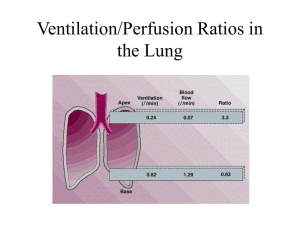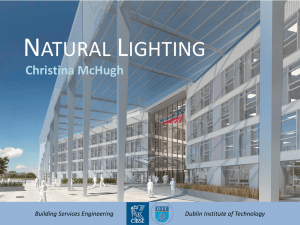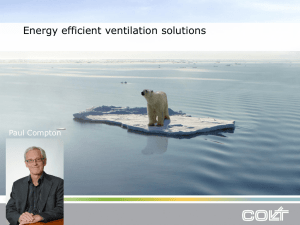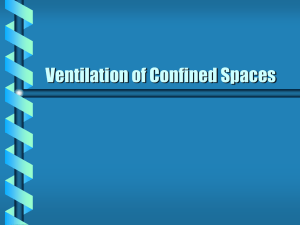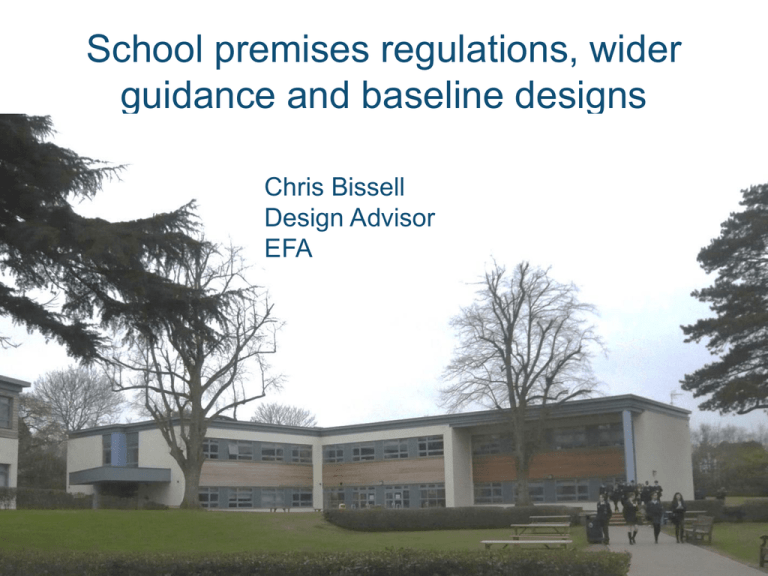
School premises regulations, wider
guidance and baseline designs
Chris Bissell
Design Advisor
EFA
Recent Changes
2012: School Premises Regulations simplified
•Clearer and fewer
•Less prescriptive, leaving detail in guidance
2011: funding reduced
•gross area funded reduced by average 6% of BB99, 15%
of BB98
•Cost per m2 reduced to £1450 total (£1113 building)
School Premises Regulations
Capital Review recommended:
• That the Department revises its school premises
regulations and guidance to remove unnecessary
burdens and ensure that a single, clear set of regulations
apply to all schools. The Department should also seek to
further reduce the bureaucracy and prescription
surrounding BREEAM assessments
• Consultation ran from 3 November to 26 January 2012
• Revised regulations signed off in July and will come into
force 31 October 2012 and January 2013
Rationale
• Three (well four) sets of DfE premises regulations, plus a
substantial amount of other legislation that applies to all
buildings including schools
• Some school specific regulations required to ensure the
needs of pupils are met, particularly on issues that could
impact on welfare or education
• Makes sense to have the same regulations for
maintained and independent schools, including
Academies and free schools
• Clarify requirements and avoid duplication of other
legislation
The ISSs refer to the SPRs in part and to the NMS, which in
Turn refer to the SPRs for detail…..and then there’s the Statutory
Framework for the Early Years Foundation Stage.
Regulations being removed
• Duplication – requirements that are covered in other pieces of
legislation. For example:
• Weather protection
• Drainage
• Fire Safety
• Unnecessary – requirements that do not need to be regulated and
are best left to the School. For example:
• Security (covered by H&S + Safeguarding)
• Standard of decoration
• Furniture and fittings
Regulations which are being removed
Classroom Size
Independents/Academies
Classroom size should be appropriate to allow effective teaching and no
area of school should compromise health or safety.
Staff Accommodation
Maintained
Covers provision of a head teacher’s room and separate accommodation for
staff to use for work and social purposes
Ancillary – Storage &
Circulation
Maintained
Provision of storage space for pupils’ belongings and to permit safe passage
within buildings.
Food Preparation & Service
All Schools
Under ISRs, where food is served, there must be adequate facilities for
hygienic preparation, serving and consumption. Under SPRs, schools must
provide adequate facilities for the preparation and serving of food and
drinks.
Security
- generally
- shared premises
Independents/Academies
Security arrangements are adequate for the grounds and buildings.
Where premises are shared for non-school purposes, the health, safety and
welfare of pupils are safeguarded and their education is not interrupted by
other users.
Access to Buildings
Independents/Academies
Allowing safe entry and exit for all pupils, including those with disabilities
and special educational needs.
Load Bearing Structures
All Schools
Load bearing structures should be capable of safely sustaining the loads
and forces they are subjected to.
Weather Protection
All Schools
Requirement that schools should be able to resist penetration from rain,
wind and snow and moisture arising from the ground.
Fire Safety
All Schools
Fire resistance of building elements and provision of adequate means of
escape in case of fire.
Heating
All Schools
Minimum temperatures are set for different types of areas in schools that
heating systems should be capable of maintaining.
Ventilation
All Schools
Ventilation in each room shall be controllable, and rates are set for the
amount of fresh air for different types of room.
Drainage
All Schools
Drainage System shall be adequate for hygiene purposes and the disposal
of waste water.
Cleanliness
Independents/Academies
Classrooms and other parts of the school shall be maintained in a clean, tidy
and hygienic state.
Decoration
Independents/Academies
Satisfactory standard and adequate maintenance of decoration.
Furniture & Fittings
Independents/Academies
Furniture and fittings are appropriately designed for the age and needs of
the pupils.
Flooring
Independents/Academies
There is appropriate flooring in good condition.
The rationale for their removal is that they either duplicate what is
covered in other legislation or they are unnecessary
Regulations being retained
• Seven areas that will apply to all schools
• Toilet and washing facilities
• Medical accommodation
• Health, safety and welfare
• Acoustics
• Lighting
• Water supplies.
• Outdoor space
• Six additional areas for boarding schools
What’s different?
• Regulations have been written much more
straightforwardly.
• Focus on provision being suitable to meet the needs of
pupils, having regard to their age, number and sex and
any special requirements they may have
• Removal of prescription – e.g. floor area in m2 for
boarding schools, precise numbers of toilets and ratio of
urinal/washbasin provision, lux levels
• Guidance significantly reduced, but does include some
advice where regulation has been removed.
• See Standards for School Premises
Wider Guidance
• We also consulted on our approach to guidance.
• Over 5000 pages, much of which is out of date, has
been superseded, or just very, very lengthy.
• Proposals to streamline guidance cover
•
•
•
•
•
•
•
Area guidelines for mainstream and special schools
Acoustics, fire, ventilation, (BBs 93/100/101)
Compendium for special schools and special units
Compendium for mainstream schools
Outdoor spaces (now to be integrated in compendia)
Procurement mini-guides for schools
Technical mini-guides for schools – e.g. fire safety
Current Design Guides - including guidance on compliance with the
Building Regulations
BB 101, Ventilation of school buildings, downloadable only, 2006 (62 pages)
BB 100, Design for Fire Safety in Schools, NBS/RIBA 2007 (158 pages)
BB 93, Acoustic Design of Schools, TSO 2003 (207 pages)
Current Design Guides - design and technical guidance
BB 102, Designing for disabled children and children with special educational
needs, TSO 2008 (199 pages)
BB 99, Briefing Framework for Primary School Projects, TSO 2006 (64 pages)
BB 98, Briefing Framework for Secondary School Projects, TSO 2004 (64
pages)
BB 96, Meeting the educational needs of children and young people in hospital
(DES/DOH) TSO 2003 (85 pages)
BB 95, Schools for the Future, TSO 2002 (77 pages)
BB 92, Modern Foreign Languages Accommodation, TSO 2000 (50 pages)
BB 89, Art Accommodation in Secondary Schools, TSO 1998 (60 pages)
BB 88, Fume Cupboards in Schools, TSO 1998 (56 pages)
BB 81, Design and Technology Accommodation in Schools, TSO revised 2004
(185 pages)
BB 80, Science Accommodation in Secondary Schools, revised 2004 (53 pages)
BB 79, Passive Solar Schools: A Design Guide, TSO 1995 (99 pages)
Any questions so far?
School premises
regulations
Design guidance
Baseline designs
Capital Review recommended:
• That a suite of standardised drawings and specifications
is prepared which could easily be applied across a wide
range of educational facilities.
Baseline designs:
• Do use standardised dimensions and have suites of
spaces, but are not templates that everyone must use.
• Can be taken and developed into detailed schemes, or
Contractors can propose alternative designs.
• Will evolve further in response to feedback and further
versions will be added.
Baseline designs
Aim to demonstrate what can be achieved within area
and cost constraints and, initially, PSBP PFI FOS.
Will demonstrate how a wide range of school-specific
requirements can be accommodated
Will match typical SoAs for a range of school sizes
(so far for a 420 primary and 1200 secondary)
How we got to where we are
Collate best
practice in recent
designs and
guidance
Lessons Learnt
from recent
schools through
POE
Test and agree
reduced area
standards
Identify best
practice principles
Identify new OS
requirements to
resolve common
problems
Agree criteria for
different suites with
expert panels
Test affordable
solutions in baseline designs
Utilisation of space in primary
Primary net capacity based on:
30 ‘basic’ workplaces in 49m2 classroom
At least 70% of ‘basic’ workplaces must be used for
classrooms
Primary Schedule of Accommodation allows:
55m2 minimum size of classroom
62m2 in reception and nursery
Optional specialist space
Hall or studio for each FE
Primary: 420 5-11 + nursery
Flexibility
Larger classrooms
or
Specialist space
Lessons learned:
early years
Nursery and reception in
early years suite
Coats and toilets off
classroom and playground
for infants
62m2 classrooms
Lessons learned:
entrance and admin
Public access only to
lobby and interview room
Open reception desk
Facilities available to
community without access
to main school
Sick bay and MI/ therapy
room
Utilisation of space in secondary
Secondary net capacity based on:
67% to 75% of ‘basic’ workplaces utilised at any one time
in 11-16 (less in sixth form)
Secondary Schedule of Accommodation:
As BB98: same number of rooms
Teaching spaces at bottom end of acceptable range
Circulation and dining within acceptable range
Full-service kitchen sufficient for 1/3 pupils to eat hot
meals and 2/3 to have cold or other options
Secondary 1200
11-16
Lessoned learned:
performing arts
Movable bleacher seating
rather than sliding/folding
screen
Central access from
dining/foyer space
Flexible performing area
with control room at back
Drama space accessible
from performance area as
‘back stage’ facility
Lessons learned:
D&T
• Prep/storage at end of
workshops
• Identity to a suite
• Links to other subjects
Flexibility
Secondary ‘superblock’
Lessons learned:
science
Suite of spaces
Central prep room
Chemical store
83m2 general labs or
90m2 specialist labs and
69m2 science studio
Lift for easy deliveries
“Baseline designs represent a challenge for architects and
contractors to improve upon”
Baseline designs – internal environment
Design uses natural
Simple to operate – users
ventilation and daylight as
can easily adjust the
much as possible
temperature and the
ventilation
Comfortable to work in –
tackles overheating
Daylighting
Daylight
Principles
Light from two sides
Tall spaces with
windows right up to
the soffit
Improved quantity
and quality of light
Climate Based Daylight Modelling
Daylight Factor replaced by two
criteria:
Daylight Autonomy- 50% of each
space to be able to be lit by sunlight
and daylight during the occupied
hours of the day
Useful Daylight Index- requires
80% of the space between 100-2000
lux
Floor to ceiling
height is 3.3m
where no external
obstructions exist.
Daylight
Roof lights are
placed over the
corridor openings to
maximise the
internal daylight.
North Façade
Glazing is 30% of
the internal wall
where no external
obstructions exist.
Internal reflections
must be 70/50/20 as
a minimum.
The acoustic baffles
are located away
from the window
openings.
South façade
glazing requires a
light shelf or light
redirecting
component.
Internal Glazing is
25% of the internal
wall façade. This
provides secondary
light into the space.
Open / translucent
balustrade design is
required to allow
light to distribute to
the lower floors.
The ground floor
opening is 1.2m
wide to provide
daylight to the
ground floor spaces.
The first floor
opening is 1.8m
wide to allow
daylight to the lower
floors..
Acoustics
Sound absorption to
circulation space
Concrete roof
provides rain noise
control
Suspended Class A
absorbers
Class A absorbent
wall panels
Attenuated high
level ventilators
either side of glazed
panel
Acoustic performance
standards for the Priority
Schools Building Programme’
replaces BB93
Fire
BS 9999:2008 Code of practice for fire safety in the design, management and use
of buildings,
Floor to ceiling
height is 3m and
depth 7.8m.
Exposed concrete
soffits with night
purge.
The acoustic baffles
and lighting raft
obscure 40% of
soffit
Acoustically treated
air path to
circulation space
Actuated insulated
louvres in roof
upstand.
Glazing is 30% of
the internal wall ,
light shelf for
shading and solar
control glass
Ventilation slots link
the circulation
spaces through the
building..
Thermal Comfort
Ventilation
Principles
More demanding
comfort criteria
Cross ventilation
Exposed concrete
soffits
Minimum openable
areas
Controllability
Performance in use
Adaptive Thermal Comfort
CIBSE Overheating Task Force
Operative Temperature = Air
temp + Radiant temp
Design Summer Year not Test
Reference Year
Two of 3 Criteria:
Overheating – duration above
max outside < 40hrs
Degree of overheating
Upper limit
Thermal Comfort Criteria
BB101 revisions
5% Floor Area as Equivalent Area
on Façade
BB101
Criterion 1 - 120 hours < 28°C
Criterion 2 - Mean ΔT < 5°C
Criterion 3 - Max 32°C Temperature
BB101 Compliance
CIBSE Adaptive
Criterion 1 - 40 hours < Θmax
Criterion 2 - 0 days < (We<10)
Criterion 3 - 0 hours < Θmax
Adaptive Compliance
Single
Sided No
Night
Purge
Single
Sided
Night
Purge
PASS
FAIL
FAIL
FAIL
PASS
PASS
PASS
PASS
PASS
PASS
PASS
PASS
FAIL
FAIL
PASS
FAIL
FAIL
FAIL
PASS
FAIL
FAIL
FAIL
PASS
FAIL
7.5% Floor Area as Equivalent
Area on Façade
Single
Cross Vent
Sided No
+ Night
Night
Purge
Purge
Single
Sided
Night
Purge
Cross Vent
+ Night
Purge
PASS
PASS
FAIL
PASS
PASS
PASS
PASS
PASS
PASS
PASS
PASS
PASS
FAIL
FAIL
PASS
FAIL
FAIL
FAIL
PASS
FAIL
PASS
FAIL
PASS
PASS
Single sided is not allowed.
Natural Ventilation Secondary
Ventilation via open circulation
Floor to ceiling
height is 3.3m and
depth 7.8m.
Exposed concrete
soffits with night
purge.
The acoustic baffles
and lighting raft
obscure 40% of
soffit
Actuated insulated
louvres in roof
upstand.
Glazing is 30% of
the internal wall ,
light shelf for
shading and solar
control glass
Ventilation slots link
the circulation
spaces through the
building..
Acoustically treated
air path to
circulation space
Demonstrated in secondary
Natural Ventilation Secondary
Ventilation via chimneys
Exposed concrete
soffits with night
purge.
Ventilation Stacks
Floor to ceiling
height is 3.3m and
depth 7.8m.
Demonstrated in primary
Winter Ventilation- heat recovery
Delivering energy efficiency



